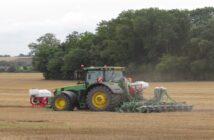Routine subsoiling could have a detrimental effect on long-term soil structure, so growers must ensure any cultivation decisions are based on sound science and identified need not habit or theory, leading agronomy firm Hutchinsons says.
Although subsoiling can alleviate short-term drainage issues in the following crop, it should only be used to rectify identified compaction issues. Used routinely, as normally occurs with deep non- inversion tillage, it disrupts natural structuring and may exacerbate future drainage problems, technical manager Dick Neale warns.
“Rapid passage of water through soil is not a natural process. Water should percolate through slowly and be stored in and between aggregates until needed.
“Subsoiling allows water to quickly drain away from the surface through the large macro pores and fissures created by the leg, but this often sees fine sand and silt particles washed to the base of the work where they pack tightly to form a sedimentation pan.
“This sedimentation can come back to haunt you in following seasons, usually in drought years when root growth is restricted from passing through this hard layer at depth.”
Mr Neale also questions the value of subsoiling tramlines if the following crop is to be drilled in the same direction as before, resulting in new tramlines over the same position. “It’s a waste of time and money and means machinery ends up travelling on what is likely to be the softest part of the field.”
Wherever possible he says non-mechanical methods, such as cover cropping, traffic management and improvements to organic matter placement to encourage earthworms, should be employed to maintain soil structure through natural processes, thereby improving long-term structure, drainage and water-holding capacity.
Inspecting soil structure is key to deciding on the most appropriate cultivation and cropping strategy for individual fields and growers are encouraged to take advantage of the new Healthy Soils service from Hutchinsons to get an accurate measure of soil health.
There is also a timely opportunity now for farmers to do their own basic assessments of soil structure prior to cultivating land.
“Normally soil is too dry to dig inspection holes at this time of year, but the wet summer means there is enough soil moisture to get a good idea of what structure really looks like and make the right decisions about what management is required,” says Mr Neale.
It is an approach favoured by Hutchinsons agronomist Kieran Walsh in the Cotswolds who says test digs are an invaluable way of tailoring autumn cultivations, especially where there are big variations in soil type.
“It’s a great opportunity to identify the presence, extent and depth of any compaction, but also to evaluate other aspects like slug pressure for the following crop and general soil health. Simple things like looking at the number of worms, texture and smell of the soil can tell you a lot about what’s going on beneath the surface.
In some situations there may be a genuine need for deeper cultivations, but in other cases shallow tillage, or even no cultivation may be more effective, which will also save time and money, he says.
Factors such as weed burden add another layer of complexity to the decision-making process and can influence cultivation type, he adds. The presence of onion couch, for example, means tine cultivators should be used to pull up weeds and allow them to dry on the surface, whereas disc cultivators chop up the weed and can spread the problem.
“Cultivation strategy is such an important aspect to discuss with your agronomist, especially after seasons like this one, which really highlight differences in soil types and any underlying issues that need addressing. Simple issues can have quite a big impact through the growing season,” Mr Walsh says.
“Soil is the most precious resource we have on farms and I believe in-depth soil analysis is more vital now than at any time in the past.”
Mr Walsh also reminds farmers to avoid the temptation to cultivate soils when conditions are too wet and to ensure cultivation equipment is set up correctly to maintain the working depth required.
[Panel] Healthy soils
Healthy Soils is a new service from Hutchinsons providing farmers with a bespoke report detailing many aspects of soil health.
Soil tests are best conducted when there is a growing crop and adequate soil moisture, typically between October and April.
Information contained in a soil audit includes:
- Review of cropping and cultivation practices
- Visual evaluation of soil structure through the profile, to 1m deep where possible
- Infiltration test to identify structural issues
- Soil health and texture assessment
- Measure of earthworms within top 200mm
- pH analysis at three depths: surface, 150mm and 300mm
- Assessment of macro and micro nutrients
- Yield potential assessment and identification of limiting factors using the Omnia service from Hutchinsons.




